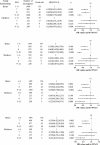The independent and joint role of socioeconomic status and family relationships on mortality risk in China: cultural differences and health inequalities in the context of intergenerational cohabitation
- PMID: 40660323
- PMCID: PMC12261701
- DOI: 10.1186/s13690-025-01669-2
The independent and joint role of socioeconomic status and family relationships on mortality risk in China: cultural differences and health inequalities in the context of intergenerational cohabitation
Abstract
Background: Socioeconomic status (SES) and family relationships are critical social determinants of health disparities. The mechanisms underlying their interactions remain insufficiently understood in Asian cultures with prevalent intergenerational cohabitation. This study investigates the independent and combined effects of SES and family relationships on all-cause mortality in China.
Methods: A baseline survey was conducted in 2010 involving 9280 adult permanent residents from 12 counties (districts) in Guizhou Province, using stratified cluster random sampling. Two follow-ups (2016-2020, 2023) were conducted. SES was assessed using a composite score comprising household income, education, and occupation, while family relationships were classified as either "good" or "mediocre." The Cox proportional hazards model was employed to evaluate the independent and combined effects of SES and family relationships on all-cause mortality.
Results: Among 5949 participants were included, and the cumulative mortality rate was 6.4% over a median follow-up of 12 years. With a decrease in mortality risk as SES increased (P < 0.001). Compared with SES ≤ 6, mortality risk with SES scores of 7, 8, and ≥ 9 decreased by 36.9% (HR = 0.631, 95% CI = 0.473-0.842), 36.6% (HR = 0.644, 95% CI = 0.469-0.886), and 73% (HR = 0.270, 95% CI = 0.183-0.397), respectively. The independent effect of family relationship on the risk of death was not statistically significant (HR = 0.847, 95% CI = 0.0.670- 1.070). The joint analysis showed the compensatory effect was significant when SES exceeded a threshold (SES ≥ 9), alleviating the mortality risk associated with family relationships (HR = 0.2197, 95% CI = 0.073-0.652).
Conclusion: Findings demonstrate SES independently reduces mortality in Chinese populations, while the effect of family relationships is modulated by cultural background. The resource substitution hypothesis is valid at specific SES thresholds. Intervention efforts should prioritize the vulnerable group characterized by "low SES and weak family support".
Keywords: All-cause mortality; Family ties; Intergenerational cohabitation; Resource substitution hypothesis; Socioeconomic position.
© 2025. The Author(s).
Conflict of interest statement
Declarations. Ethics approval and consent to participate: This study was approved by the Institutional Review Board of Guizhou Province Center for Disease Control and Prevention (No. S2017-02), and written informed consent was signed by all subjects. Our research adhered to the Declaration of Helsinki. Consent for publication: Not applicable. Competing interests: The authors declare no competing interests.
Figures





Similar articles
-
Comparison of Two Modern Survival Prediction Tools, SORG-MLA and METSSS, in Patients With Symptomatic Long-bone Metastases Who Underwent Local Treatment With Surgery Followed by Radiotherapy and With Radiotherapy Alone.Clin Orthop Relat Res. 2024 Dec 1;482(12):2193-2208. doi: 10.1097/CORR.0000000000003185. Epub 2024 Jul 23. Clin Orthop Relat Res. 2024. PMID: 39051924
-
Sexual Harassment and Prevention Training.2024 Mar 29. In: StatPearls [Internet]. Treasure Island (FL): StatPearls Publishing; 2025 Jan–. 2024 Mar 29. In: StatPearls [Internet]. Treasure Island (FL): StatPearls Publishing; 2025 Jan–. PMID: 36508513 Free Books & Documents.
-
Impact of residual disease as a prognostic factor for survival in women with advanced epithelial ovarian cancer after primary surgery.Cochrane Database Syst Rev. 2022 Sep 26;9(9):CD015048. doi: 10.1002/14651858.CD015048.pub2. Cochrane Database Syst Rev. 2022. PMID: 36161421 Free PMC article.
-
Mediation effect of healthy lifestyles on the association of socioeconomic status with mortality among US cancer survivors: a population-based cohort study.Int J Surg. 2025 Jul 11. doi: 10.1097/JS9.0000000000002904. Online ahead of print. Int J Surg. 2025. PMID: 40643263
-
Self-management interventions including action plans for exacerbations versus usual care in patients with chronic obstructive pulmonary disease.Cochrane Database Syst Rev. 2017 Aug 4;8(8):CD011682. doi: 10.1002/14651858.CD011682.pub2. Cochrane Database Syst Rev. 2017. PMID: 28777450 Free PMC article.
References
-
- Zhou M, Wang H, Zeng X, Yin P, Zhu J, Chen W, Liang X, et al. Mortality, morbidity, and risk factors in China and its provinces, 1990–2017: A systematic analysis for the Global Burden of Disease Study 2017. The Lancet Public Health. 2021;6(5):e330–9.
-
- Zhong S, Lee C, Foster MJ, et al. Intergenerational communities: A systematic literature review of intergenerational interactions and older adults’ health-related outcomes[J]. Soc Sci Med. 2020;264. 10.1016/j.socscimed.2020.113374. - PubMed
-
- Das M, Anand A, Barman P, et al. Exploring the relationship between socioeconomic status and teenage pregnancy in India: a review on National Family Health Survey[J]. SN Social Sciences. 2024;4(4). 10.1007/s43545-024-00889-7.
Grants and funding
- Qiankehe (2018)2819/Guizhou Province Science and Technology Support Program
- Qiankehe (2018)2819/Guizhou Province Science and Technology Support Program
- Qiankehe (2018)2819/Guizhou Province Science and Technology Support Program
- Qiankehe (2018)2819/Guizhou Province Science and Technology Support Program
- Qiankehe (2018)2819/Guizhou Province Science and Technology Support Program
LinkOut - more resources
Full Text Sources

